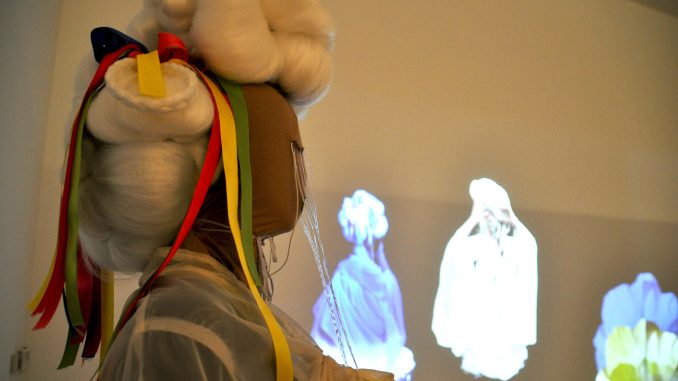
While visiting Philadelphia in 2019 for a solo art presentation at Vox Populi, an art gallery located on 11th and Wood Streets, Jova Lynne walked alongside a bookstore named Giovanni’s Room, the name of one her favorite books written by James Baldwin.
In the window was his book “Notes of a Native Son,” which inspired the latest exhibition Lynne curated.
“It’s a series of essays where James Baldwin sort of deals with the dichotomy of America, sort of demystifying, specifically from a Black, gay, male, poor perspective, like what it means to be of this country,” said Lynne, director of exhibitions and public programs at Temple Contemporary.
Lynne, a first generation Columbian and Jamaican American, solidified her idea for “With or Without You: America,” an exhibit featuring 11 first-generation American artists depicting moments of their experiences with assimilation, college and race. The exhibition is open until Oct. 29 at Temple Contemporary, an art exhibit at the Tyler School of Art and Architecture.
Lynne saw racial injustices and the public health crisis caused by COVID-19 in 2020 while also reading Baldwin’s book that discussed topics like the American Dream and its flaws.
“I just started thinking of all these intricate connections of the first-generation identity that was inclusive of first-generation immigrant kids, but also thinking about, just genuinely what it means to be a pioneer of America,” Lynne said.
The exhibition’s artwork includes photographs, paintings and video installations from artists who live throughout the United States.
“The work isn’t being like ‘I’m first-generation, here’s what my thoughts are on first-generationhood,’ it’s not that,” Lynne said. “The show is about personhood, it’s about being of a place, and being both within that place and having to develop systems without that place.”
Two featured artists in the exhibition, Antonia Larkin and Valery (정) Jung Estabrook, explore loss and death in their artwork through videos they choreographed and performed in.
Estabrook, a Korean American artist, assimilated into American culture and experienced the loss of her Korean culture. Her feelings of grief are showcased by performing a ritual movement piece inspired by Korean funeral ceremonies.
“The histories and perspectives that are included are incredibly important, of course are still just a slice of the American experience,” Estabrook said. “But as far as an exhibition can go, it is still quite an impressive representation of the diversity and complexity of the different experiences that we as first-generation Americans and the families that we belong to, what those experiences entail.”
Although Estabrook and Larkin are from different backgrounds, they have both encountered loss and grief within their communities.
Larkin, who was once a first-generation college student, integrates her experiences as a Black woman with her female ancestors, she said. After conducting individual research of her family’s ancestry, she found mainly death records.
In one video, Larkin highlights how the Black community celebrates the death of loved ones, even if they died in non-peaceful ways, like by police brutality, she said. In her artwork, she hopes to honor her ancestors and highlight how Black people have experienced racism and discrimination.
“I got really into the idea of how Black people mourn and how Black people have celebrations of life ceremonies and homegoing’s, and its somber, but it also feels kind of like a party in a way,” Larkin said. “But the lives we live are often not so celebratory, and the way Black people die, thinking of people like Latasha Harlins and Breonna Taylor, the way they came to die was under someone else’s control and it wasn’t with any honor.”
Amy Shindo, a curatorial and program assistant at Temple Contemporary and 2022 master of fine arts in ceramics alumna, worked with Lynne and the exhibition’s manager, Adam Blumberg, by talking with featured artists and working on the artists’ contracts, she said.
Shindo, a first-generation Japanese American from Canada, felt a connection to the artists because of issues they experienced in the U.S., like finding a voice as a minority.
“Each artist had such a unique vision about their experience, and so what that helped me to do was mine what my own experiences have been and are now,” Shindo said.
Lynne looks forward to hosting and directing upcoming exhibition events throughout the fall semester, including workshops and walk-through tours, to connect Temple and Philadelphia community members with the artwork.
“As this is an exhibition that is about personhood and agency, hearing from the artists directly is just such a powerful experience,” Lynne said.


Be the first to comment